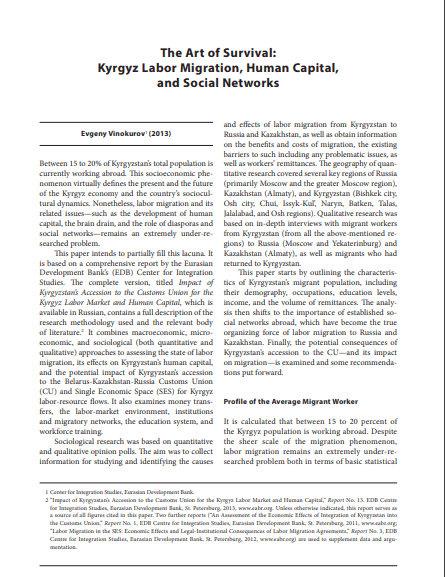The Art of Survival: Kyrgyz Labor Migration, Human Capital, and Social Networks
In: Laruelle, M. (ed.) Kyrgyzstan: Political Pluralism and Economic Challenges. The George Washington University: Washington D.C. P. 49-57.
Between 15 to 20% of Kyrgyzstan’s total population is currently working abroad. This socioeconomic phenomenon virtually defines the present and the future of the Kyrgyz economy and the country’s sociocultural dynamics. Nonetheless, labor migration and its related issues—such as the development of human capital, the brain drain, and the role of diasporas and social networks—remains an extremely under-researched problem. This paper intends to partially fill this lacuna. It is based on a comprehensive report by the Eurasian Development Bank’s (EDB) Center for Integration Studies. The complete version, titled Impact of Kyrgyzstan’s Accession to the Customs Union for the Kyrgyz Labor Market and Human Capital, which is available in Russian, contains a full description of the research methodology used and the relevant body of literature.2 It combines macroeconomic, microeconomic, and sociological (both quantitative and qualitative) approaches to assessing the state of labor migration, its effects on Kyrgyzstan’s human capital, and the potential impact of Kyrgyzstan’s accession to the Belarus-Kazakhstan-Russia Customs Union (CU) and Single Economic Space (SES) for Kyrgyz labor-resource flows. It also examines money transfers, the labor-market environment, institutions and migratory networks, the education system, and workforce training.
Sociological research was based on quantitative and qualitative opinion polls. The aim was to collect information for studying and identifying the causes and effects of labor migration from Kyrgyzstan to Russia and Kazakhstan, as well as obtain information on the benefits and costs of migration, the existing barriers to such including any problematic issues, as well as workers’ remittances. The geography of quantitative research covered several key regions of Russia (primarily Moscow and the greater Moscow region), Kazakhstan (Almaty), and Kyrgyzstan (Bishkek city, Osh city, Chui, Issyk-Kul’, Naryn, Batken, Talas, Jalalabad, and Osh regions). Qualitative research was based on in-depth interviews with migrant workers from Kyrgyzstan (from all the above-mentioned regions) to Russia (Moscow and Yekaterinburg) and Kazakhstan (Almaty), as well as migrants who had returned to Kyrgyzstan.
